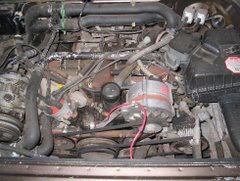 What a productive and enjoyable day we had. The morning class covered chapters 2 and 3 of Mike Brown's Convert It, and Mike showed a GM promotional video for the EV-1 from 1990. Then everyone was shown the safety stations in the shop and the non-technicians were trained on how to safely use the lift and other automotive tools. They were also taught safety procedures in case of battery acid exposure, eye injuries, and fire.
What a productive and enjoyable day we had. The morning class covered chapters 2 and 3 of Mike Brown's Convert It, and Mike showed a GM promotional video for the EV-1 from 1990. Then everyone was shown the safety stations in the shop and the non-technicians were trained on how to safely use the lift and other automotive tools. They were also taught safety procedures in case of battery acid exposure, eye injuries, and fire.Over lunch Dan and Bill produced a plan for the battery layout in the van. Now we needed more detailed drawings of that -- and Mike triumphantly produced plans that he'd drawn up while back home in Turlock, based on the probable layout. He said, "If two groups come up independently with the same plan, it's probably a pretty good one." His drawings will help us arrange for fabrication of the battery boxes, and he also advised us on the thicknesses of aluminum and aluminum angle that should be used.
After lunch the work groups were let loose and there was a whirr of activity in the shop. The photos can't possibly do it justice! It was all happening at once!
Barry and Larry developed a plan for attaching the motor to the transmission.
Peter and Lynn removed the Vanagon's transmission -- technically referred to as a "transaxle" -- under Dan's guidance. No easy job!
Dan is happily pointing out some Vanagon quirks to Bill, a former Vanagon owner himself.
Mike, Bill, Frank (a teacher at the vo-tech who is kindly helping us out with some of the machining), Barry, and Kevin are listening to Larry, whose engineering background gives him an immediate grasp of the electrical components involved in the vehicle.

Speaking of which, I forgot to include a shot yesterday of the parts all laid out on their tarp. The engine has come off the left hand corner, and a big pile of (unlabeled) rags already seems to have sneaked onto the display tarp, but but we are trying to keep everything visible and accessible!
At the end of the day we debriefed, congratulated ourselves
on having gotten so much done, and made a list of supplies that will be needed. This is only part of it; there are two whiteboards this size in Bill's classroom. I teased Mike for putting an i-Mac on the list, but he really does need a computer -- his old one will no longer connect to the internet or print! He's doing what he can with overheads and a sharpie, though.


















































